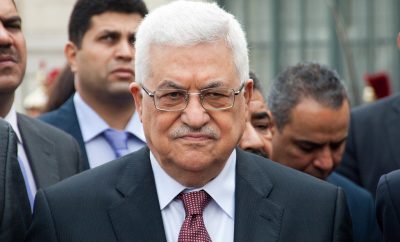 "Palestine - Hebron - 30" Courtesy of Kyle Taylor; License: (CC BY 2.0)
"Palestine - Hebron - 30" Courtesy of Kyle Taylor; License: (CC BY 2.0)
World
Where Does the U.S. Stand on the Two-State Solution?
In the words of President Donald Trump, it would be the “ultimate deal.” But it is a deal that has flummoxed the negotiating partners for 70 years: the elusive partitioning of historic Palestine into two states, Israel and Palestine. For decades, the U.S. has been a vital broker for and backer of a two-state path. But with Donald Trump in office, the standard, seemingly immortal U.S. position may be in question. In a Wednesday press conference with Israeli Prime Minister Benjamin Netanyahu, Trump said he is “looking at two-state and one-state” solutions, and he prefers “the one that both parties like.”
Trump’s statements cannot be chiseled in stone to represent a permanent shift in the U.S. stance. For one, Nikki Haley, the U.S. Ambassador to the United Nations directly contradicted Trump on Thursday at a Security Council session on the Israeli-Palestinian conflict. “We absolutely support a two-state solution,” Haley said. “But we are thinking out of the box as well, which is–what does it take to bring these two sides to the table, what do we need to have them agree on?”
David Friedman, Trump’s choice for ambassador to Israel, also expressed support to the two-state solution in his confirmation hearing on Thursday. “It still remains the best possibility for peace in the region,” he said. And despite the fact that Friedman has poured millions of dollars into an Israeli settlement in the West Bank, he said settlements “may not be helpful” for peace, adding that it “makes sense to tread very carefully in that area.”
Present Dilemma: Waning Desire for a Two-State Solution
So while Trump’s envoys say one thing, he says another. Though he has not decisively aborted the two-state route, he has said he is open to other, less popular routes. But as we have seen, a fleeting statement at a press conference might not always coalesce into a sturdy position for Trump.
For instance, after he won the election, he accepted a call from Taiwan, infuriating China, which worried he would abandon the decades-old “One China” policy. Trump further compounded China’s fury when he explicitly questioned the wisdom of “One China.” But then Trump backtracked. He recently told Chinese President Xi Jinping the U.S. will recognize the longstanding policy. The threat of an unprecedented U.S. pivot subsided.
Now, a rogue Taiwan provoking Trump into undermining “One China” is not quite on the same scale as a true shift in U.S. policy regarding the two-state solution. But Trump has shown that he can be in flux, and say one thing on Monday, and another thing on Thursday.
Regardless of the American position on the intractable conflict, alternatives to the two-state solution seem to be gaining steam. It is unclear what other paths to peace would look like, but one thing is fairly clear: a slim majority of Israelis and a large minority of Palestinians still support two states. According to a Palestinian Center for Policy and Survey Research poll, 55 percent of Israelis, and 44 percent of Palestinians back a two-state solution. Support for a single, bi-national state is fractured in Israel, as 19 percent of Israeli Jews and 56 percent of Israeli Arabs support that idea. Thirty-six percent of Palestinians support a single state.
But despite popular support on both sides, the political will to strike a deal is withering. The Palestinian leadership is fractured among the Palestinian Authority (PA) in the West Bank and Hamas–a designated terrorist group by the U.S., Europe, and Israel–in the Gaza Strip. And in Israel, an emboldened right-wing government that is calcifying its position that a two-state solution is an impossible by encouraging more settlement growth. Netanyahu still supports two states, though of late he has primarily alluded to his position than thrown his full weight behind it.
Past Failures
It is useful to understand the history of the two-state ordeal. In 1937, before Israel was established as a state, a British commission recommended partitioning the land of Palestine into two states–one for Jews, one for Arabs. In terms of land mass, the proposed Arab state would have dwarfed the Jewish state. The Jews accepted the plan, and the Arabs declined. A decade later, in 1947, the U.N. voted for a similar partition plan. Again, the Jews accepted the internationally-backed plan; the Arabs did not, instead deciding to launch a full-scale war against Israel, after it was established as a state, in 1948.
Israel won the War of Independence but ceded the territory now known as the West Bank and Gaza to Jordan and Egypt respectively. In June 1967, Jordan and Egypt prepared to launch a second war against Israel, with the promise of obliterating the Jewish State. Israel launched a preemptive strike, won the war, and control of the West Bank and Gaza changed hands: from that point on, Israel occupied the territories that would make up any future Palestinian state.
The next opportunity–and the last true glimmer of peace–came in 2000 during the Camp David Summit. In late July, President Bill Clinton, the first U.S. leader to attempt to broker a two-state solution, announced the two sides were unable to reach an agreement. Jerusalem, which both sides claim as their capital, was the ultimate, insurmountable obstacle to lasting peace.
Future Success?
And now, nearly two decades later, here we are: Israeli settlements are slowly creeping along the hills of the West Bank; Hamas fires rockets indiscriminately into Israel; the PA glorifies violence against Israelis and praises martyrs. The two-state solution is looking more dim and unlikely than ever before.
So where does the U.S., the most important international player in the conflict, stand? Of course, before Trump, there was President Barack Obama, who, like previous U.S. administrations, steadfastly supported two states. Trump has shown less opposition to Israeli settlements than his predecessors, and he has expressed an openness to other solutions in a way that is unprecedented for a U.S. president.
But, though reading the tea leaves of Trump’s mind is a precarious business, it seems that he is in favor of two states. As many people still believe, and as U.N. Secretary-General António Guterres recently said, “There is no Plan B to the situation between Palestinians and Israelis but a two-state solution.”








Comments